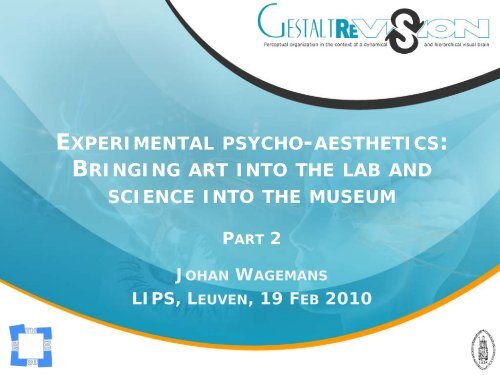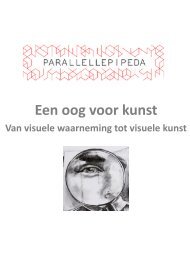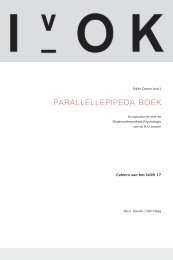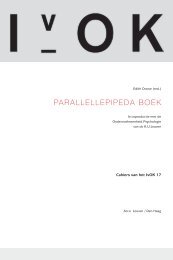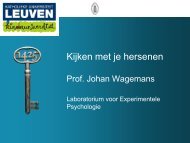Experimental psycho-aesthetics: Bringing art into ... - Gestalt ReVision
Experimental psycho-aesthetics: Bringing art into ... - Gestalt ReVision
Experimental psycho-aesthetics: Bringing art into ... - Gestalt ReVision
Create successful ePaper yourself
Turn your PDF publications into a flip-book with our unique Google optimized e-Paper software.
EXPERIMENTAL PSYCHO-AESTHETICS:<br />
BRINGING ART INTO THE LAB AND<br />
SCIENCE INTO THE MUSEUM<br />
PART 2<br />
JOHAN WAGEMANS<br />
LIPS, LEUVEN, 19 FEB 2010
Contents<br />
1. (historical) introduction to experimental<br />
<strong>psycho</strong>-<strong>aesthetics</strong><br />
2. variety of research topics and research<br />
styles<br />
3. implications for <strong>psycho</strong>logy as a whole<br />
4. some Parallellepipeda projects<br />
5. towards a new kind of experimental<br />
<strong>psycho</strong>-<strong>aesthetics</strong>?
4.<br />
SOME PARALLELLEPIPEDA PROJECTS
Parallellepipeda<br />
• an interdisciplinary (cross-over) project on the<br />
boundary between <strong>art</strong>s and sciences<br />
• an initiative of a number of p<strong>art</strong>ners in Leuven:<br />
– “Kunst in Huis” (Kristel Eggermont, Raf Coenjaerts)<br />
– the dep<strong>art</strong>ment of cultural affairs of the City of Leuven<br />
(Steven Dusoleil)<br />
– the City Museum M (Lore Vanhees)<br />
– STUK/Artefact (Pieter-Paul Mortier)<br />
– the Association K.U. Leuven/IvOK (Jan Baetens, Jan De<br />
Vuyst)<br />
• Note: IvOK stands for “Instituut voor Onderzoek in<br />
de Kunsten” (“Institute for Research in the Arts”),<br />
which allows a number of <strong>art</strong>ists to obtain their PhD<br />
in Arts (not <strong>art</strong>s science or <strong>art</strong>s history, but really<br />
practice-based <strong>art</strong>s).
Parallellepipeda<br />
• Different projects<br />
• Laboratory of <strong>Experimental</strong> Psychology and 4<br />
<strong>art</strong>ists:<br />
– Ruth Loos (visual, PhD)<br />
– Wendy Morris (visual, PhD)<br />
– Anne-Mie Van Kerckhoven (visual)<br />
– Carl Van Eyndhoven (Lemmens Institute, carillon, PhD)<br />
• Others:<br />
– Ronny Delrue (visual, PhD) + Koen Van Laere (nuclear<br />
medicine)<br />
– Nick Ervinck (visual) + Pierre Delaere (experimental<br />
ORL)<br />
– Koen Vanmechelen + Jean-Jacques Cassiman (human<br />
genetics) + Luc Vrielinck (stomatology)
What I will do here<br />
• present a brief introduction about the<br />
<strong>art</strong>ists and their work<br />
• present one or two examples of studies<br />
we did in relation to their work (in the<br />
context of Parallellepipeda)<br />
– some from early stage of collaboration (close<br />
to standard lab work)<br />
– some from later stage of collaboration (more<br />
remote from standard lab work)<br />
• briefly mention other (on-going) projects
Ruth Loos<br />
• preparing a Ph.D. thesis on different aspects<br />
of “the book object”<br />
• important graphical/visual component to her<br />
work:<br />
– repetition, symmetry,<br />
balance<br />
– 2D vs 3D<br />
– texture<br />
– scale<br />
– perspective<br />
– visual relations<br />
– …
opgerold boek met paraffine-schijfje en touw
opgerold boek met paraffine-schijfje en touw
“sea of stories - fairy tales”
studie van losse pagina’s: paraffine op kalkpapier
doordrukalfabetbladen en gedroogde koraal
oeken ontbonden, pagina’s herschikt tot lopende meters
“h<strong>art</strong>en en dragers” - plaaster, papier, inkt, naaigaren
Early stage experiment<br />
• forced choice and ranking task with<br />
several series of works<br />
• ideas: balance/composition (visual<br />
rightness)<br />
• method:<br />
– which one do you like most?<br />
– which one do you like least?<br />
– rank order the remaining in-between these<br />
extremes<br />
– which one do you think is the original?
Example
And the correct answer is…
96 op 126 cm (één van drie) 7
Later stage study (quasi-experiment)<br />
• collaboration with Elisabeth Van Lierop<br />
• manipulation/evaluation during an exhibition<br />
• exhibition is divided in 2 halves: left/right of<br />
diagonal, one with and one without<br />
additional information (counterbalanced<br />
across p<strong>art</strong>icipants)<br />
• additional information in this case:<br />
explanation by well-informed guide<br />
• evaluation in this case: standard<br />
questionnaires but also semi-structured<br />
interviews (checking whether we made them<br />
look differently)<br />
• relate viewing/knowing to appreciation
Basic design<br />
• 2 halves of the exhibition: A and B<br />
• 4 groups of p<strong>art</strong>icipants: 1, 2, 3 and 4<br />
• 4 conditions:<br />
(1) A without info – measurements for A<br />
B with info – measurements for B<br />
(2) A with info – measurements for A<br />
B without info – measurements for B<br />
(3) B without info – measurements for B<br />
A with info – measurements for A<br />
(4) B with info – measurements for B<br />
A without info – measurements for A
On-going project<br />
• similar study during Parallellepida<br />
exhibition in M
Wendy Morris<br />
• preparing a Ph.D. thesis on her movie work<br />
• animated charcoal drawings<br />
• important visual component<br />
to her work:<br />
– spatiotemporal variations<br />
– translations, transformations,<br />
invariance<br />
– traces, analogies<br />
– micro-macro<br />
– visual detail<br />
– …
Later stage project<br />
• eye movement and visual memory study (with<br />
Peter De Graef & Line Denayer)<br />
• animation film: “Off the Record”<br />
• multiple viewings (1-2-3)<br />
• with or without additional information (2 types:<br />
biographical/historical versus anecdotal/visual)<br />
• in-between: same aesthetic appreciation (5point<br />
scales)<br />
• afterwards:<br />
– unexpected recognition memory test, using static<br />
images from the same film (40 targets) or another film<br />
(40 distractors)<br />
– same personal background questionnaire (general <strong>art</strong><br />
interest, familiarity of the work)
Basic design<br />
• 3 groups of p<strong>art</strong>icipants<br />
• 3 conditions:<br />
(1) view 1 – no information – view 2 – view 3<br />
(2) view 1 – information A – view 2 – view 3<br />
(3) view 1 – information B – view 2 – view 3<br />
• memory experiment
Yes
Yes
Yes
Yes
Analysis<br />
• compare eye movements between different<br />
viewers, different conditions (with/without<br />
additional information)<br />
• compare eye movements within viewers,<br />
between different viewings (1-2-3), before<br />
and after additional information<br />
• relate eye movements to visual aspects<br />
(→ additional visual information)<br />
• relate eye movements to content<br />
(→ additional verbal information)<br />
• relate eye movements to appreciation<br />
• relate eye movements to memory
Example result
On-going project<br />
• “Audio-visual contract”<br />
– original soundtrack<br />
– two new soundtracks
Anne-Mie Van Kerckhoven<br />
• best-known <strong>art</strong>ist<br />
• works with a lot of different techniques (also<br />
digital)<br />
• important visual component<br />
to her work:<br />
– perceptual organization<br />
– 2D vs 3D<br />
– contours vs surfaces<br />
– figure-ground ambiguities<br />
(e.g., perceptual holes)<br />
– multiple depth layers<br />
– depth cues<br />
– …
Early stage experiment<br />
• free sorting task with “I’ll rob you” (36<br />
drawings on colored paper, 12 weeks,<br />
Lakenhalle, Bruges, 2005)<br />
• question: do people see connections<br />
between the drawings?<br />
• method: free sorting
• color of paper<br />
• color of central blob<br />
Sorting criteria<br />
• female present or not<br />
• furniture present or not<br />
• female: body and head integrated or not<br />
• one or more blobs<br />
• homogenously colored background or not<br />
• …
Later stage study<br />
• eye movement study with “Kalligrafie”<br />
- with Peter De Graef & Karen De Ryck<br />
- a series of 15 drawings<br />
• goal: to get insight in the process of<br />
viewing and appreciating <strong>art</strong> by<br />
– studying on-line visual sampling<br />
– relating scan parameters to<br />
• questionnaire measures of <strong>art</strong> appreciation<br />
– explicit (evaluative statements and ratings)<br />
– implicit (Osgood semantic differential)<br />
– as a function of<br />
• level of <strong>art</strong> experience<br />
• level of episodic experience<br />
• interpretive set available to the viewer
Methods<br />
• drawings photographed and viewed on a CRT<br />
• 2 groups of subjects<br />
– novices, no formal or informal <strong>art</strong> training (N = 22)<br />
– experts: <strong>art</strong>ists – <strong>art</strong> students (N = 22)<br />
• basic design<br />
– A. 20 sec viewing per drawing (eye movements)<br />
• followed by evaluation questionnaires<br />
– B. 20 sec viewing per drawing (eye movements)<br />
• followed by evaluation questionnaires<br />
• p<strong>art</strong>icipants see interview with <strong>art</strong>ist prior to phase A (half<br />
of the group) or prior to phase B (other half)
• the <strong>art</strong>ist<br />
• checking balance<br />
Effects of <strong>art</strong> expertise<br />
on individual scan paths
• the novice<br />
• reading<br />
Effects of <strong>art</strong> expertise<br />
on individual scan paths
• the expert<br />
• checking composition<br />
Effects of <strong>art</strong> expertise<br />
on individual scan paths
Preliminary conclusions<br />
• information sampling strategy appears to reflect<br />
the viewer’s “purpose”<br />
– <strong>art</strong> novices are attempting to understand the work<br />
• look for informative clues (text)<br />
– <strong>art</strong> experts are attempting to read and evaluate the<br />
work<br />
• look for compositional structure<br />
– may be more sensitive to the intentional use of <strong>Gestalt</strong>-based<br />
composition<br />
• evaluate details of form, colour use, technique<br />
• not quite focal vs ambient, rather different types<br />
of focal
5.<br />
TOWARDS A NEW KIND OF EXPERIMENTAL<br />
PSYCHO-AESTHETICS?
A new kind of <strong>psycho</strong>-<strong>aesthetics</strong><br />
• working with real, active <strong>art</strong>ists who are<br />
scientifically interested and motivated<br />
• added value<br />
– new kinds of research<br />
– new insights in visual perception<br />
– new view on relations between <strong>art</strong>s and sciences<br />
• multi-method approach<br />
• neuro-<strong>aesthetics</strong>: PET study on visual creativity<br />
• lessons for <strong>psycho</strong>logy as a whole<br />
– studying rich topics is possible<br />
• perception/cognition/emotion<br />
• multifactorially determined<br />
– multi-method<br />
– we can do more than we think
• visit the exhibition<br />
Invitation to …<br />
• attend Thursday evening lectures<br />
– 25 Feb: Ruth Loos, Volkmar Mühleis<br />
– 25 March: Semir Zeki, Koen Van Laere, Johan<br />
Wagemans<br />
– 15 April: Wendy Morris, Carl Van Eyndhoven,<br />
Géry d’Ydewalle<br />
• p<strong>art</strong>icipate in on-going research<br />
– as experimenter<br />
– as visitor/p<strong>art</strong>icipant
THANK YOU<br />
www.gestaltrevision.be<br />
johan.wagemans@psy.kuleuven.be


